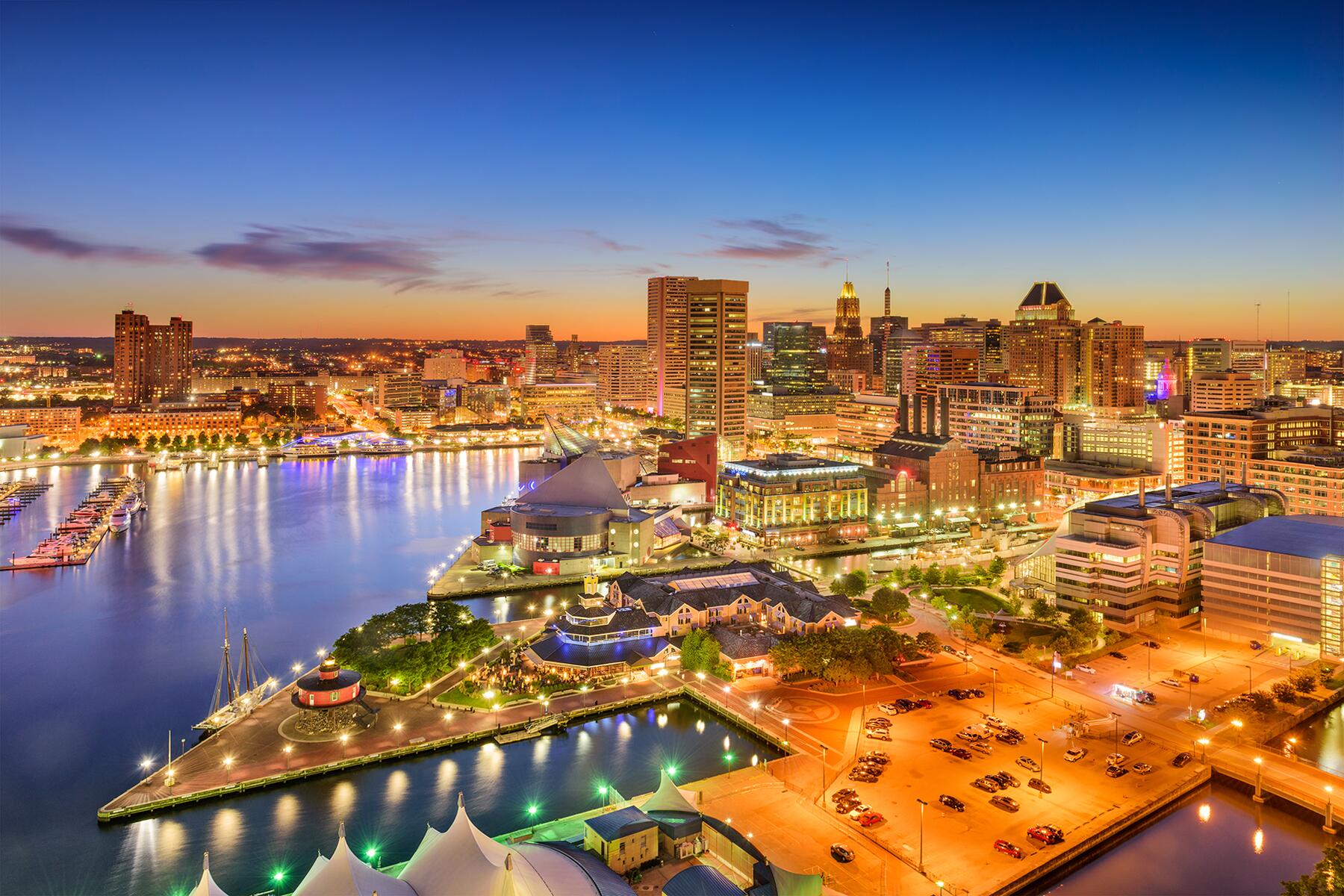This port city is home to several notable institutions, monuments, and more than 56,000 significant properties; Baltimore is a trove of African American history.
Baltimore, Maryland, is distinguished by its abundance of seemingly oxymoronic characteristics. It’s charming but gritty, quaint though contemporary, refined yet rough around the edges. Yet, somehow all these adjectives work together to make it a genuinely lovely city.
This city, like most in the country, is not without issues. But at the core of Baltimore’s story is a rich history with deep roots in the abolition and civil rights movements. These histories have shaped Baltimore’s identity and provide insight into the people, their resilience, and a city pride that’s ubiquitous here.
To experience Baltimore’s Black history for yourself, you don’t have to veer far from your itinerary.
Related: 11 Places to Connect With Washington, D.C.’s Rich Black History
Walk in Frederick Douglass’s Footsteps in Fells Point
You can kick off your lesson in Black history by taking a stroll in Baltimore’s Fells Point neighborhood. You will feel like you’ve teleported back in time. This trendy neighborhood, with its vintage stone streets lined with centuries-old buildings, is a treasure trove of history.
One of its most famous residents was abolitionist, author, and statesman Frederick Douglass. In his autobiography, Douglass wrote that as an enslaved child, he worked as a ship caulker in Fells Point. It was here that he taught himself to read and write and later escaped to freedom.
Many free and enslaved African Americans lived in Fells Point and worked in nearby shipyards. The vestiges of this thriving African American community can be found in two tiny wood-framed houses called the Two Sisters. The houses are some of the last remaining buildings that give insight into the lives of the many African Americans who lived and worked in Fells Point before the Civil War. The homes are currently being restored.
Frederick Douglass-Isaac Myers Maritime Park
While meandering through Fells Point, make a stop at the Frederick Douglass-Isaac Myers Maritime Park. The shipyard-turned-museum is a 15,000-square-foot gallery space where you can learn about Baltimore’s abundant Black maritime history and shipbuilding tradition.
It highlights Douglass’s life and recreates the first marine shipyard and railway operated by Isaac Myers, an African American entrepreneur. The museum features exhibits on the development of Baltimore’s maritime industry and was once the first Black-owned shipyard in the United States.
Recommended Fodor’s Video
Reginald F. Lewis Museum of Maryland African American History & Culture
The Reginald F. Lewis Museum of Maryland African American History & Culture is two blocks from Baltimore’s uber-popular Inner Harbor. The museum opened in 2005, named after Baltimorean Reginal F. Lewis, the first African American to establish a billion-dollar company.
The Lewis Museum has about 10,000 artifacts in its collection, making it the largest African American museum in Maryland. It’s also an affiliate of the Smithsonian Institute and is an excellent resource for learning about the lives of African American Marylanders.
Lillie Carroll Jackson Civil Rights Museum
No lesson in Baltimore’s Black history is complete with a chapter on Lillie Carroll Jackson. Learn about the life and work of Baltimore’s mother of the civil rights movement at the Lillie Carroll Jackson Civil Rights Museum.
A lightning rod of action, Dr. Jackson was a pioneer of the civil rights movement. She became the leader of the Baltimore chapter of the NAACP in 1935, and for more than three decades, she rallied to register Black voters and led boycotts to promote integration in the city.
Dr. Jackson and her family’s legacies are far-reaching. Her daughter, Juanita Jackson, became the first African American woman in Maryland to practice law, and her son-in-law was the famed civil rights lobbyist Clarence M. Mitchell, Jr.
Visit Morgan State University
Morgan State University is the largest historically Black University in Maryland, and its campus is in Baltimore. It’s also one of the first Historically Black Colleges and Universities to be designated national treasure by the National Park Service.
This beacon of higher education offers graduate and undergraduate degrees in more than 60 programs. It is also responsible for awarding the largest number of degrees to African American students in Maryland.
Some notable Morganites include publishing and business mogul Earl G. Graves, Sr., political journalist and author April Ryan, comedian Joe Clair, and actress Mo’Nique.
National Great Blacks in Wax Museum
Get an up-close look at Black historical figures at the National Great Blacks in Wax Museum. The museum, which opened in a former fire station, has more than 150 life-size wax statues and scenes honoring Black history.
The museum is organized chronologically, starting in Ancient Africa and continuing through the Harlem Renaissance and Civil Rights Movement to the present. Some of the most notable wax figures include Booker T. Washington, Rosa Parks, and President Barack Obama.
Historic President Street Station (Formerly Baltimore Civil War Museum)
Not far from the Inner Harbor is the Historic President Street Station (formerly Baltimore Civil War Museum). The museum is historically significant for a few reasons. First, it’s housed in a train station that was once the terminus of the Philadelphia, Wilmington, and Baltimore Railroad. And it was an important crossing for the Underground Railroad and the Civil War.
As one of the oldest train stations in the nation, it houses a collection of artifacts about railroad history in Maryland and tells the story of Baltimore during the Civil War and the building’s role in the Underground Railroad.
INSIDER TIPThe museum is currently closed for the season. It will reopen in March.
Clarence M. Mitchell, Jr. Courthouse
While meandering through downtown Baltimore, stop by the Clarence M. Mitchell, Jr. Courthouse. The courthouse was dedicated to Mitchell in honor of his work as a civil rights leader and chief NAACP lobbyist on Capitol Hill for nearly three decades. He was nicknamed the “101st U.S. Senator” for his efforts and perseverance in getting Congress to recognize the constitutional rights of African Americans. Mitchell played an integral role in the passage of the Civil Rights Act of the 1950s and 1960s.
When the courthouse was renamed in 1985, it was said to be the first courthouse in a major U.S. city to be named after an African American.
Maryland Center for History and Culture
Maryland Center for History and Culture contains more than 350,000 artifacts and seven million books and documents that tell African American life stories in Baltimore. The collection includes nine portraits by Joshua Johnson, who is known as the first professional African American artist in the country. The museum also showcases 7,000 photographs taken from 1929 to 1965 by Paul Henderson, a photojournalist with the Baltimore Afro-American newspaper.
Eubie Blake Cultural Center
The Eubie Blake Cultural Center is an excellent stop on a quest to learn more about Baltimore’s rich Black history. The center is named after Baltimore’s own Eubie Blake, a ragtime and jazz pianist, composer, and lyricist who was acclaimed for his work on Broadway.
The center offers workshops, youth programs, and even jazz, neo-soul and classical performances by local musicians.
Benjamin Banneker Historical Park & Museum
While not technically within the boundaries of Baltimore, the Benjamin Banneker Historical Park and Museum is worth the 20-minute drive to Cantonsvile.
The park and museum are dedicated to telling the story of Benjamin Banneker, an autodidactic astronomer, mathematician, and almanac author. Banneker is attributed with helping to establish the original boundaries of Washington, D.C. This 142-acre site is located on Banneker’s former farmstead, includes exhibits on colonial America and natural history, and has a dedicated gallery that tells the scientist’s life story.






